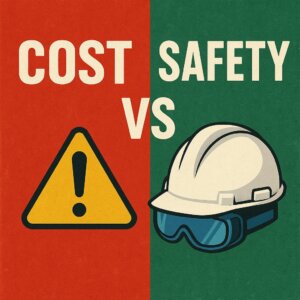Personal Protective Equipment (PPE) is crucial for ensuring employee safety in high-risk environments like construction sites, manufacturing plants, and more. However, just like any equipment, PPE wears down over time. So, how can you extend the lifespan of your PPE? In this article, we’ll explore some simple yet effective maintenance tips that can help you save costs while ensuring your gear is always ready to provide the best protection.
1. Regular Inspections: Catch Issues Early
Regularly inspecting PPE is the first step to prolonging its life. By checking for potential problems early, you can address them before they lead to further damage.
- Helmets and Face Shields: Look for cracks, discoloration, or other signs of damage. Cracks can weaken the protective capabilities of the equipment.
- Gloves and Footwear: Check for wear and tear, especially in high-use areas. Durability is key when it comes to protecting workers.
- Reflective Vests and Safety Harnesses: Inspect for damaged zippers, frayed edges, or missing reflective strips.
By conducting routine inspections and making timely repairs, you can significantly extend the life of your PPE.
2. Proper Cleaning and Storage: Prevent Excessive Wear
After extensive use, cleaning and proper storage are essential to maintaining PPE. Items like protective clothing and gloves may accumulate dirt and debris over time, which can affect their performance.
- Cleaning Methods: Each type of PPE has specific cleaning requirements. For example, some protective clothing may need to be hand-washed to avoid damaging the material.
- Storage: Avoid storing PPE in direct sunlight or high-temperature areas, as UV rays and excessive heat can cause materials to degrade.

3. Avoid Unnecessary Physical Damage: Use PPE Correctly
PPE is designed to provide optimal protection, but improper use can lead to premature damage. For example:
- Avoid contact with sharp objects to prevent tearing protective clothing.
- Ensure PPE is worn correctly to avoid overstretching or applying unnecessary pressure.
By using PPE properly, you can reduce the risk of damage from incorrect handling.
4. Adopt Smart Technology: Use Sensors to Monitor Equipment
Modern technology has brought new opportunities for PPE maintenance. Some high-end PPE now integrates sensors and smart devices to monitor the condition of the gear in real time. With smart technology, you can get immediate data on the wear and tear of the equipment, allowing you to take action before the problem becomes severe.
| PPE Item | Inspection Frequency | Maintenance Tips |
| Helmets | Monthly | Check for cracks and avoid exposure to high temperatures |
| Safety Gloves | Weekly | Wash by hand and air dry; avoid overstretching |
| Reflective Vest | Biweekly | Wash with cold water and avoid direct sunlight |
| Safety Shoes | Monthly | Clean soles and check for signs of wear |
5. Update When Necessary: Avoid Overuse
While regular maintenance can prolong the life of PPE, every item has a shelf life. If PPE is showing signs of aging or has lost its effectiveness, it’s important to replace it. Regularly evaluate the condition of each piece of equipment and update when necessary.
Conclusion: Key Steps to Prolong PPE Lifespan
Extending the lifespan of your PPE doesn’t require complicated procedures. Simply following a few basic maintenance principles — regular inspections, proper cleaning, avoiding physical damage, adopting smart technology, and updating when needed — can help ensure your equipment stays in top condition.
By maintaining your PPE, you’re not only improving workplace safety but also reducing the long-term costs of frequent replacements.
Remember, proper PPE maintenance is the first step toward ensuring the safety of your workforce. We hope these tips help you keep your PPE in the best shape possible!








